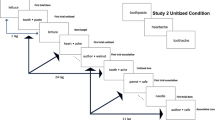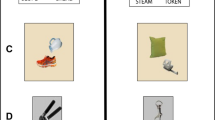Abstract
Studies designed to explore memory for single items versus paired items (i.e., associative memory) in young adults show inconsistent results. Some studies report a decrease in associative recognition and others report mild-to-moderate or even a null effect. The studies often do not take into account stimuli serial position (SSP) when analyzing the locus of associative accuracy. Studies testing SSP often target memory for items, while studies targeting associative memory decline as a function of SSP are lacking. The objective of the current study is to test the separate and joint effect of SSP (experiments 1 + 2) and presentation duration (experiment 2) on memory recognition for items versus associations. We hypothesized that greater associative decline (compared to the expected decline in memory for items with similar serial location) will be observed for the material located at the end of a learning list than the material located at the beginning of a learning list. The results of the two experiments converged and confirmed our hypotheses; the greatest associative deficit was observed for associative material located at the end of the learning list (experiments 1 + 2) and for material presented for short durations (experiment 2). The interaction between SSP and presentation duration did not reach significance; however, a direct estimation of the cumulative deficit of SSP and presentation duration confirmed our hypothesis regarding greater associative deficit for recently presented items for short durations. These results highlight the importance of the joint and separate, effect of SSP and presentation duration to the study of associative memory decline.


Similar content being viewed by others
References
Aggleton, J. P., & Brown, M. W. (1999). Episodic memory, amnesia, and the hippocampal–anterior thalamic axis. Behavioral and Brain Sciences, 22(03), 425–489..
Aggleton, J. P., & Shaw, C. (1996). Amnesia and recognition memory: A re-analysis of psychometric data. Neuropsychologia, 34(1), 51–62.
Baddeley, A. (1992). Working memory. Science, 255(5044), 556.
Brodie, D. A., & Murdock, B. B. (1977). Effect of presentation time on nominal and functional serial-position curves of free recall. Journal of Verbal Learning and Verbal Behavior, 16(2), 185–200.
Brubaker, M. S., & Naveh-Benjamin, M. (2014). The effects of presentation rate and retention interval on memory for items and associations in younger adults: A simulation of older adults’ associative memory deficit. Aging, Neuropsychology, and Cognition, 21(1), 1–26.
Capitani, E., Della Sala, S., Logie, R. H., & Spinnler, H. (1992). Recency, primacy, and memory: Reappraising and standardising the serial position curve. Cortex, 28(3), 315–342.
Corballis, M. C. (1967). Serial order in recognition and recall. Journal of Experimental Psychology, 74(1), 99.
Craik, F. I., & Rabinowitz, J. C. (1985). The effects of presentation rate and encoding task on age-related memory deficits. Journal of Gerontology, 40(3), 309–315.
Davachi, L., Mitchell, J. P., & Wagner, A. D. (2003). Multiple routes to memory: Distinct medial temporal lobe processes build item and source memories. Proceedings of the National Academy of Sciences, 100(4), 2157–2162.
Davachi, L., & Wagner, A. D. (2002). Hippocampal contributions to episodic encoding: insights from relational and item-based learning. Journal of Neurophysiology, 88(2), 982–990.
Diana, R. A., Yonelinas, A. P., & Ranganath, C. (2007). Imaging recollection and familiarity in the medial temporal lobe: a three-component model. Trends in cognitive sciences, 11(9), 379–386.
Eichenbaum, H., Sauvage, M., Fortin, N., Komorowski, R., & Lipton, P. (2012). Towards a functional organization of episodic memory in the medial temporal lobe. Neuroscience & Biobehavioral Reviews, 36(7), 1597–1608.
Glanzer, M., & Cunitz, A. R. (1966). Two storage mechanisms in free recall. Journal of verbal learning and verbal behavior, 5(4), 351–360.
Greene, R. L. (1986). Sources of recency effects in free recall. Psychological Bulletin, 99(2), 221–228.
Guez, J., Cohen, J., Naveh-Benjamin, M., Shiber, A., Yankovsky, Y., Saar, R., & Shalev, H. (2013). Associative memory impairment in acute stress disorder: Characteristics and time course. Psychiatry Research, 209(3), 479–484.
Guez, J., & Lev, D. (2016). A picture is worth a thousand words? Not when it comes to associative memory of older adults. Psychology and Aging, 31(1), 37–41.
Guez, J., & Naveh-Benjamin, M. (2015). Proactive interference and concurrent inhibitory processes do not differentially affect item and associative recognition: Implication for the age-related associative memory deficit. Memory, 24, 1–17.
Guez, J., Naveh-Benjamin, M., Yankovsky, Y., Cohen, J., Shiber, A., & Shalev, H. (2011). Traumatic stress is linked to a deficit in associative episodic memory. Journal of traumatic stress, 24(3), 260–267.
Henke, K., Weber, B., Kneifel, S., Wieser, H. G., & Buck, A. (1999). Human hippocampus associates information in memory. Proceedings of the National Academy of Sciences, 96(10), 5884–5889.
Hirshman, E., & Hostetter, M. (2000). Using ROC curves to test models of recognition memory: The relationship between presentation duration and slope. Memory & Cognition, 28, 161–166.
Hockey, R. (1973). Rate of presentation in running memory and direct manipulation of input-processing strategies. The Quarterly Journal of Experimental Psychology, 25(1), 104–111..
Isaac, C. L., & Mayes, A. R. (1999a). Rate of forgetting in amnesia: I. Recall and recognition of prose. Journal of Experimental Psychology: Learning, Memory, and Cognition, 25(4), 942.
Isaac, C. L., & Mayes, A. R. (1999b). Rate of forgetting in amnesia: II. Recall and recognition of word lists at different levels of organization. Journal of Experimental Psychology: Learning, Memory, and Cognition, 25(4), 963.
Laughery, K. R., & Pinkus, A. L. (1966). Short-term memory: Effects of acoustic similarity, presentation rate and presentation mode. Psychonomic Science, 6(6), 285–286.
Leding, J. K., & Lampinen, J. M. (2009). Memory conjunction errors: The effects of presentation duration and study repetition. Memory, 17(5), 597–607..
Mayes, A. R., Holdstock, J. S., Isaac, C. L., Hunkin, N. M., & Roberts, N. (2002). Relative sparing of item recognition memory in a patient with adult-onset damage limited to the hippocampus. Hippocampus, 12(3), 325–340.
McDermott, K. B., & Watson, J. M. (2001). The rise and fall of false recall: The impact of presentation duration. Journal of Memory and Language, 45(1), 160–176.
McElree, B. (2006). Accessing recent events. Psychology of Learning and Motivation, 46, 155–200.
Murdock, B. B. Jr. (1962). The serial position effect of free recall. Journal of Experimental Psychology, 64(5), 482.
Naveh-Benjamin, M., Guez, J., Kilb, A., & Reedy, S. (2004). The associative memory deficit of older adults: Further support using face-name associations. Psychology and Aging, 19(3), 541.
Naveh-Benjamin, M., Guez, J., & Marom, M. (2003). The effects of divided attention at encoding on item and associative memory. Memory & Cognition, 31(7), 1021–1035.
Naveh-Benjamin, M., Guez, J., & Shulman, S. (2004). Older adults’ associative deficit in episodic memory: Assessing the role of decline in attentional resources. Psychonomic Bulletin & Review, 11(6), 1067–1073.
Naveh-Benjamin, M., Hussain, Z., Guez, J., & Bar-On, M. (2003). Adult age differences in episodic memory: further support for an associative-deficit hypothesis. Journal of Experimental Psychology: Learning, Memory, and Cognition, 29(5), 826.
Naveh-Benjamin, M., & Kilb, A. (2012). How the measurement of memory processes can affect memory performance: The case of remember/know judgments. Journal of Experimental Psychology: Learning, Memory, and Cognition, 38(1), 194–203.
Neath, I. (1993). Distinctiveness and serial position effects in recognition. Memory & cognition, 21(5), 689–698.
Nee, D. E., & Jonides, J. (2008). Neural correlates of access to short-term memory. Proceedings of the National Academy of Sciences, 105(37), 14228–14233.
Nega, C. (2005). Perceptual effects and recollective experience in face recognition. Experimental Psychology, 52, 224 – 231. https://doi.org/10.1027/1618-3169.52.3.224.
Old, S. R., & Naveh-Benjamin, M. (2008). Differential effects of age on item and associative measures of memory: A meta-analysis. Psychology and Aging, 23, 104–118. https://doi.org/10.1037/0882-7974.23.1.104.
Öztekin, I., Davachi, L., & McElree, B. (2010). Are representations in working memory distinct from representations in long-term memory? Neural evidence in support of a single store. Psychological Science, 21, 1123–1133.
Ranganath, C., Yonelinas, A. P., Cohen, M. X., Dy, C. J., Tom, S. M., & D’Esposito, M. (2004). Dissociable correlates of recollection and familiarity within the medial temporal lobes. Neuropsychologia, 42(1), 2–13.
Raz, N., Lindenberger, U., Rodrigue, K. M., Kennedy, K. M., Head, D., Williamson, A., & Acker, J. D. (2005). Regional brain changes in aging healthy adults: General trends, individual differences and modifiers. Cerebral Cortex, 15(11), 1676–1689..
Rubinsten, O., Anaki, D., Henik, A., Drori, S., & Faran, Y. (2005). Free association norms in the Hebrew language. In A. Henik, O. Rubinsten, & D. Anaki (Eds.) Word norms in hebrew, (pp. 17–34) Beersheba: Ben-Gurion University of the Negev.
Rundus, D. (1971). Analysis of rehearsal processes in free recall. Journal of experimental psychology, 89(1), 63.
Saar-Ashkenazy, R., Cohen, J. E., Guez, J., Gasho, C., Shelef, I., Friedman, A., & Shalev, H. (2014). Reduced corpus-callosum volume in posttraumatic stress disorder highlights the importance of interhemispheric connectivity for associative memory. Journal of traumatic stress, 27(1), 18–26.
Saar-Ashkenazy, R., Veksler, R., Guez, J., Jacob, Y., Shelef, I., Shalev, H., & Cohen, J. E. (2016). Breakdown of inter-hemispheric connectivity is associated with posttraumatic symptomatology and memory impairment. PLOS one, 11(2), e0144766.
Sadeh, T., Ozubko, J. D., Winocur, G., & Moscovitch, M. (2016). Forgetting patterns differentiate between two forms of memory representation. Psychological Science, 27(6), 810–820.
Schon, K., Hasselmo, M. E., LoPresti, M. L., Tricarico, M. D., & Stern, C. E. (2004). Persistence of parahippocampal representation in the absence of stimulus input enhances long-term encoding: A functional magnetic resonance imaging study of subsequent memory after a delayed match-to-sample task. The Journal of Neuroscience, 24(49), 11088–11097..
Sperling, R., Chua, E., Cocchiarella, A., Rand-Giovannetti, E., Poldrack, R., Schacter, D. L., & Albert, M. (2003). Putting names to faces: Successful encoding of associative memories activates the anterior hippocampal formation. Neuroimage, 20(2), 1400–1410.
Talmi, D., Grady, C. L., Goshen-Gottstein, Y., & Moscovitch, M. (2005). Neuroimaging the serial position curve a test of single-store versus dual-store models. Psychological Science, 16(9), 716–723.
Vargha-Khadem, F., Gadian, D. G., Watkins, K. E., Connelly, A., Van Paesschen, W., & Mishkin, M. (1997). Differential effects of early hippocampal pathology on episodic and semantic memory. Science, 277(5324), 376–380.
Waugh, N. C. (1967). Presentation time and free recall. Journal of Experimental Psychology, 73(1), 39.
Weirich, S., Hoffmann, F., Meißner, L., Heinz, A., & Bengner, T. (2011). Sex influence on face recognition memory moderated by presentation duration and reencoding. Neuropsychology, 25(6), 806.
Wingenfeld, K., & Wolf, O. T. (2014). Stress, memory, and the hippocampus. Frontiers in Neurology and Neuroscience, 34, 109–120.
Yonelinas, A. P. (2002). The nature of recollection and familiarity: A review of 30 years of research. Journal of memory and language, 46(3), 441–517.
Yonelinas, A. P., Hopfinger, J. B., Buonocore, M. H., Kroll, N. E. A., & Baynes, K. (2001). Hippocampal, parahippocampal and occipitaltemporal contributions to associative and item recognition memory: An fMRI study. Neuroreport, 12(2), 359–363.
Acknowledgements
This research was supported in part by the Achva Academic College grant to the first author. We are grateful to Eldana Perlman, Katya Rabinowitch, Ruslan Bernstein and Eldad Keha for their assistance in data collection and analysis.
Funding
The study was not funded.
Author information
Authors and Affiliations
Corresponding author
Ethics declarations
Conflict of interest
Dr. Guez declares no conflict of interest. Dr. Saar-Ashkenazi declares no conflict of interest. Mrs. Tiferet-Dweck declares no conflict of interest.
Ethical approval
All procedures performed in studies involving human participants were in accordance with the ethical standards of the institutional and/or national research committee and with the 1964 Declaration of Helsinki and its later amendments or comparable ethical standards.
Informed consent
Informed consent was obtained from all individual participants included in the study.
Additional information
Publisher’s Note
Springer Nature remains neutral with regard to jurisdictional claims in published maps and institutional affiliations.
Rights and permissions
About this article
Cite this article
Guez, J., Saar-Ashkenazy, R. & Tiferet-Dweck, C. Dissociative associative-memory deficit as a function of primacy and recency effects. Psychological Research 84, 1545–1554 (2020). https://doi.org/10.1007/s00426-019-01167-5
Received:
Accepted:
Published:
Issue Date:
DOI: https://doi.org/10.1007/s00426-019-01167-5




